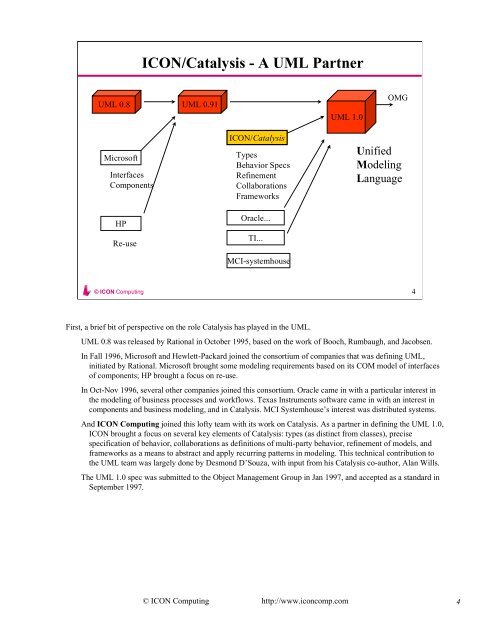Objects, Components, and Frameworks with UML The Catalysis ...
Objects, Components, and Frameworks with UML The Catalysis ...
Objects, Components, and Frameworks with UML The Catalysis ...
You also want an ePaper? Increase the reach of your titles
YUMPU automatically turns print PDFs into web optimized ePapers that Google loves.
<strong>UML</strong> 0.8<br />
Microsoft<br />
Interfaces<br />
<strong>Components</strong><br />
HP<br />
Re-use<br />
© ICON Computing<br />
ICON/<strong>Catalysis</strong> - A <strong>UML</strong> Partner<br />
<strong>UML</strong> 0.91<br />
ICON/<strong>Catalysis</strong><br />
Types<br />
Behavior Specs<br />
Refinement<br />
Collaborations<br />
<strong>Frameworks</strong><br />
Oracle...<br />
TI...<br />
MCI-systemhouse<br />
<strong>UML</strong> 1.0<br />
© ICON Computing http://www.iconcomp.com<br />
OMG<br />
Unified<br />
Modeling<br />
Language<br />
First, a brief bit of perspective on the role <strong>Catalysis</strong> has played in the <strong>UML</strong>.<br />
<strong>UML</strong> 0.8 was released by Rational in October 1995, based on the work of Booch, Rumbaugh, <strong>and</strong> Jacobsen.<br />
In Fall 1996, Microsoft <strong>and</strong> Hewlett-Packard joined the consortium of companies that was defining <strong>UML</strong>,<br />
initiated by Rational. Microsoft brought some modeling requirements based on its COM model of interfaces<br />
of components; HP brought a focus on re-use.<br />
In Oct-Nov 1996, several other companies joined this consortium. Oracle came in <strong>with</strong> a particular interest in<br />
the modeling of business processes <strong>and</strong> workflows. Texas Instruments software came in <strong>with</strong> an interest in<br />
components <strong>and</strong> business modeling, <strong>and</strong> in <strong>Catalysis</strong>. MCI Systemhouse’s interest was distributed systems.<br />
And ICON Computing joined this lofty team <strong>with</strong> its work on <strong>Catalysis</strong>. As a partner in defining the <strong>UML</strong> 1.0,<br />
ICON brought a focus on several key elements of <strong>Catalysis</strong>: types (as distinct from classes), precise<br />
specification of behavior, collaborations as definitions of multi-party behavior, refinement of models, <strong>and</strong><br />
frameworks as a means to abstract <strong>and</strong> apply recurring patterns in modeling. This technical contribution to<br />
the <strong>UML</strong> team was largely done by Desmond D’Souza, <strong>with</strong> input from his <strong>Catalysis</strong> co-author, Alan Wills.<br />
<strong>The</strong> <strong>UML</strong> 1.0 spec was submitted to the Object Management Group in Jan 1997, <strong>and</strong> accepted as a st<strong>and</strong>ard in<br />
September 1997.<br />
4<br />
4


